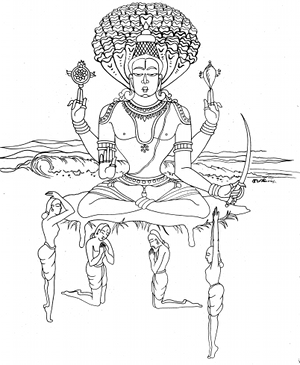Sutra Sunday – Yoga as Gardening, Patanjali’s Yoga Sutra-s IV,3
nimittam-aprayojakaṃ prakṛtīnāṃ varaṇa-bhedaḥ tu tataḥ kṣetrikavat
nimittam – skillful means/cause; instrumental in bringing about a desired transformation
aprayojakaṃ – not directly affecting a change; indirect cause; facilitating change through subtle means
prakṛtīnāṃ – to transform one’s fundamental nature/prakṛti
varaṇa – dikes, dams or walls/obstacles (blocking the flow of water)
bhedaḥ – removing, breaking open
tu – but, however
tataḥ – as a result
kṣetrikavat – like a Farmer or Master Gardener, who both knows how to work the land and do the work required to produce desired results
Translation
The skillful means of transforming our fundamental natures comes as a result of [a masterful Teacher], who like a Farmer, tends to their plants [students] by skillfully removing what blocks the flow of water to them. The Farmer [Teacher] is instrumental in facilitating this transformation, but does not directly bring it about.

Gardening during the Pandemic
As we move into Spring, many of us are starting to garden again, sometimes for the first time in years. One of the gifts of the pandemic has been an increase in gardening as a means of creating food security for our families during uncertain times. Gardening stores can’t keep up with the demand. Seeds have been flying off the shelves. Gardening is thriving in our communities, one of the silver linings of this pandemic experience.
Garden Bay Gardening
I, too, have had the great fortune of being able to garden again during the pandemic. After a quarter of a decade of living in small apartments in Vancouver, Canada, my husband and I have fortuitously ended up in our newly built home on the Sunshine Coast to work remotely from the safety of our forest dwelling in Garden Bay, British Columbia. With this sudden transition to country living last Spring, we also felt drawn to working the land, and getting our hands dirty in its rugged soil. Vegetables and flowers surrounded us by the end of last summer with my first garden in 25 years. We are looking forward to an even healthier crop this summer, but the experience has not been without its obstacles to overcome!
The Lessons of Gardening
Gardening has many lessons for us all. It takes planning, patience, and consistent effort to get results like a long-term Yoga practice does. Pruning the old and weeding the unwanted are just as important as planting new seeds, and caring for them with both water and fertilizer, all at the right time, in the right amounts. Preventing obstacles like deer who come at night to eat all of our efforts is also essential through establishing strong boundaries such as the fences that my husband, Walter is now building for us. Saying yes to new habits and mental patterns must be balanced with saying no to old ones for our continuous whole-person transformation (see Yoga Sūtra-s I-12 to 16).
Yoga as Gardening
In Yoga Sūtra IV,3, Patanjali compares personal growth to farming. In order to thrive, grow and transform, a Teacher can be instrumental in removing the blocks that are holding us back and stopping the flow of prāṇa (vital energy) to where it is needed for healing within bodies, breath and minds. Like a Farmer removes weeds, rocks, and pests to allow for growth, a skilled Teacher can be instrumental in helping us cut away that which is blocking our personal transformation. Like a skilled Farmer removes knots from an irrigation system to allow nourishing water to flow to their fields, practicing what our masterful Teacher has taught us can subtly facilitate change. This transformation can ultimately break us open to experience our spiritual essence, naturally overflowing with endless Joy as the walls that used to confine us are deconstructed. As the obstacles are gradually removed, the Prāṇa that lies hidden in our Heart of hearts starts to release step by step (see YS, I-17). We start to radiate like the Sun, becoming fully established in the power of our authentic Self, our Draṣţa (see YS, I-3).
The Fruits of our Gardening
This personal growth happens of its own accord indirectly through the healing and spiritual practices of Yoga supported by our Therapeutic Relationships. Yoga Teachers do not cause this growth directly but nurture it subtly as they tend to their students like small seedlings growing into independent plants capable of bearing extraordinary fruit. In the end, we must do the work if we want to become Free. Our Teachers can only point the way through their teachings and examples.
Happy Inner & Outer Gardening this Spring!
Happy Spring Equinox, Passover, Easter, Holi and Ramadan as we all tend to our personal transformation and growth during these uncertain times.
Yoga Sūtra Contemplative Meditation
What obstacles are holding me back from personal grow and transformation? What Yoga practices and Therapeutic Relationships can support their removal, including my relationship with my Yoga Teacher, Yoga Therapist, and/or Counsellor?


 Sundays, Maggie Reagh presents a series of blog posts on one of Patanjali’s key Yoga Sūtra-s (YS), encouraging you to reflect on how it relates to your current life situation through a Yoga Sūtra Journal Question.
Sundays, Maggie Reagh presents a series of blog posts on one of Patanjali’s key Yoga Sūtra-s (YS), encouraging you to reflect on how it relates to your current life situation through a Yoga Sūtra Journal Question. Patanjali’s Yoga Sūtra-s (YS) I-23 Īśvara (Source)-pranidhānādva (OR continuously and completely offer yourself to)
Patanjali’s Yoga Sūtra-s (YS) I-23 Īśvara (Source)-pranidhānādva (OR continuously and completely offer yourself to)
 Patanjali’s Yoga Sutra-s (YS) I-13
Patanjali’s Yoga Sutra-s (YS) I-13